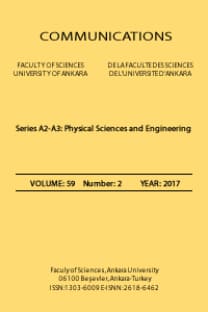RF ANTENNA DESIGN FOR BUTTON-TYPE BEAM POSITION MONITORS USING BIO-INSPIRED OPTIMIZATION METHODS
Multiple objective evolutionary algorithms, , RF Antenna Design, Beam position monitors
___
Shafer, Robert E., Beam position monitoring, AIP conference proceedings, (1992), 601–636.Smith, Stephen R., Beam position monitor engineering, AIP conference proceedings, (1997), 50–65.
Forck, P., Liakin, D. and Kowina, P., Beam position monitors, CERN Accelerator School on Beam Diagnostics, (2009), 187–228.
Nosych, A., Iriso, U. and Olle, J., Electrostatic finite-element code to study geometrical nonlinear effects of BPMs in 2D, 4th International Beam Instrumentation Conference (IBIC2015), Melbourne, Australia, (2015) 418-422
Yiğit, S. S., Ar, Y. and Bostanci, G. E., Evolutionary approaches for weight optimization in collaborative filtering-based recommender systems, Turkish Journal of Electrical Engineering & Computer Sciences, (2019), 27.3, 2121-2136.
Karim, A. M., Güzel, M. S., Tolun, M. R., Kaya, H. and Çelebi, F. V., A new generalized deep learning framework combining sparse auto encoder and Taguchi method for novel data classification and processing, Mathematical Problems in Engineering, (2018).
Mohammed, S. N., Guzel, M. S. and Bostanci, E., Classification and Success Investigation of Biomedical Data Sets Using Supervised Machine Learning Models, In 3rd International Symposium on Multidisciplinary Studies and Innovative Technologies (ISMSIT), IEEE, (2019), 1-5.
Aksoy, A., Karsli, O., Aydin, A., Kaya, C., Ketenoglu, B., Ketenoglu, D. and Yavas, O., Current status of Turkish accelerator and radiation laboratory in Ankara: the TARLA facility, Canadian Journal of Physics, 96(7), (2018), 837-842.
Aydin, A., Bostanci, E. and Tanriover, Ozgur O., A Multiple Objective Evolutionary Algorithm Approach to Find Optimal Design Parameters for Beam Position Monitoring Systems, International Journal of Modern Physics C, (2019) doi: 10.1142/ S0129183120500382
Aydin, A. and Kasap, E., Design studies for the beam position monitor (BPM) front-end electronics of the Turkish accelerator and radiation laboratory in Ankara (TARLA). Turkish Journal of Physics, 41(3), (2017), 269-276.
Eberhart, R. C. and Shi, Y., Comparison between genetic algorithms and particle swarm optimization, International conference on evolutionary programming, (1998), 611–616.
Nebro, A. J., Durillo, J. J., Garcia-Nieto, J., Coello, C.A., Luna, F. and Alba, E., SMPSO: A new PSO-based metaheuristic for multi-objective optimization, IEEE Symposium on Computational Intelligence in Multi-Criteria Decision-Making (MCDM), (2009), 66–73.
Kollat, J. B. and Reed, P. M., Comparison of multi-objective evolutionary algorithms for long-term monitoring design, World Water and Environmental Resources Congress, (2005).
Ketenoğlu, D., Bostanci, G. E., Aydin, A. and Ketenoğlu, B., A hard X-ray self-amplified spontaneous emission free-electron laser optimization using evolutionary algorithms for dedicated user applications, Turkish Journal of Physics, 43(6), (2019), 551-555.
- ISSN: 1303-6009
- Yayın Aralığı: Yılda 2 Sayı
- Başlangıç: 2019
- Yayıncı: Ankara Üniversitesi
RF ANTENNA DESIGN FOR BUTTON-TYPE BEAM POSITION MONITORS USING BIO-INSPIRED OPTIMIZATION METHODS
Ayhan AYDIN, Gazi Erkan BOSTANCI
EVALUATION OF MS-DIAL AND MZMINE2 SOFTWARES FOR CLINICAL LIPIDOMICS ANALYSIS
A STUDY ON THE SEARCH POTENTIAL OF DOUBLY CHARGED LEPTONS AT THE SppC BASED ep COLLIDERS
Aysuhan OZANSOY, Oğuzhan ALBAYRAK
AN ARTIFACT REDUCTION METHOD FOR BLOCK-BASED VIDEO CODING
Hakki Alparslan ILGIN, Ahmet AKBULUT
GENERATING TURKISH LYRICS WITH LONG SHORT TERM MEMORY
Mehmet GÜZEL, Hakan ERTEN, Erkan BOSTANCİ
THE DESIGN OF STANDALONE PV SYSTEM USING P&O ALGORITHM FOR MAXIMUM POWER POINT TRACKING
LEARNING DENSE CONTEXTUAL FEATURES FOR SEMANTIC SEGMENTATION
Hacer YALİM KELES, Long Ang LİM
BAND REDUCTION FOR TARGET DETECTION IN HYPERSPECTRAL IMAGES
Murat ŞİMŞEK, Hakki Alparslan ILGIN
THE DESIGN OF STANDALONE PV SYSTEM USING P&O ALGORITHM FOR MAXIMUM POWER POINT TRACKING
